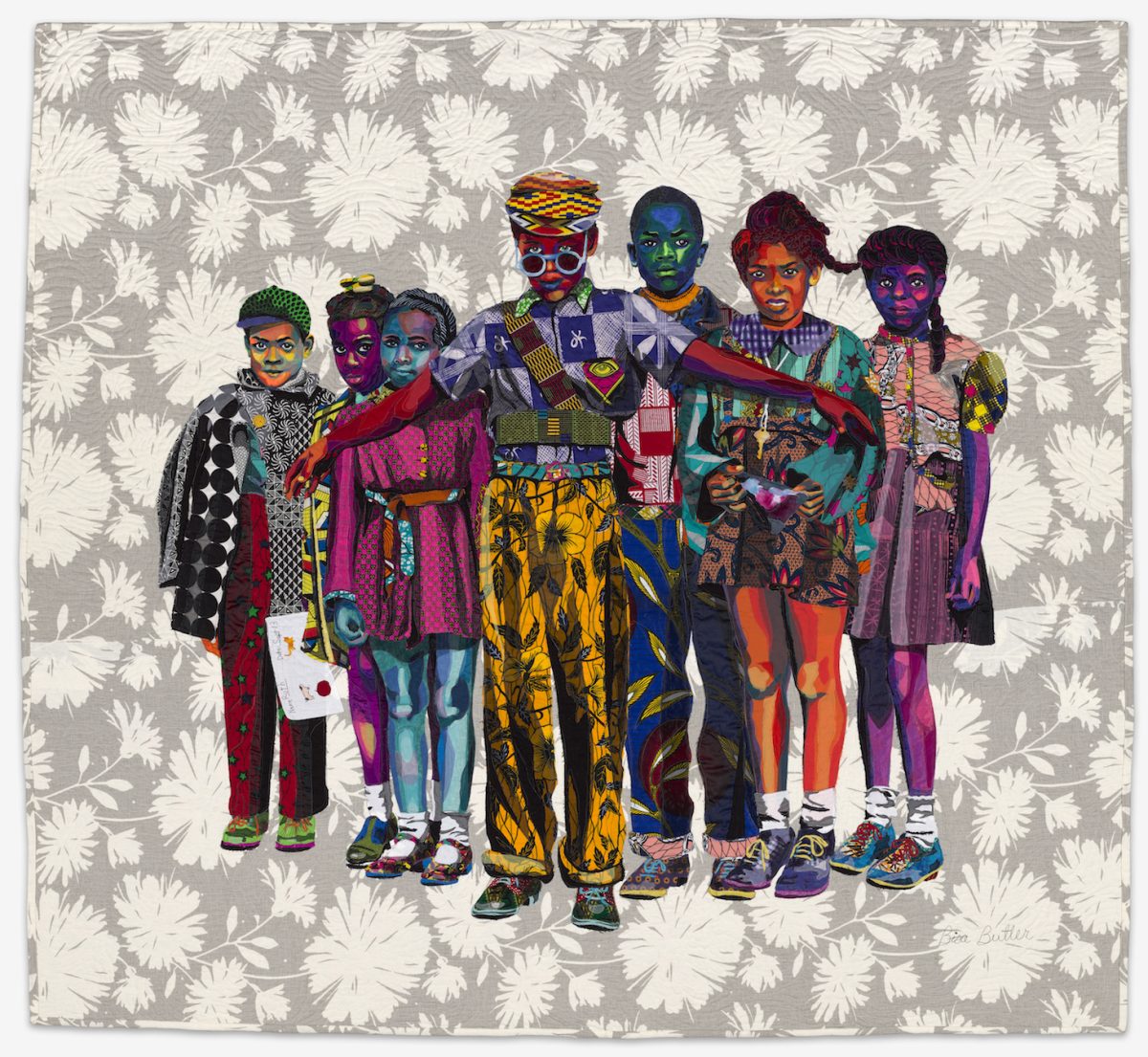
CHICAGO — Bisa Butler has a great name; it has almost a rock star quality. But she wasn’t born with it. Mailissa Veronica Yamba grew up in New Jersey, the daughter of a Ghanian-born university president (at Essex County College in Newark) and a French teacher from New Orleans. She graduated from Columbia High School in 1991, married, earned undergraduate and graduate degrees in painting and art education, and taught high school art for a decade while raising her children.
The story will sound familiar to many women artists. However, Butler has recently emerged as a significant art-world presence, with her first solo museum exhibition, Bisa Butler: Portraits, currently on view at the Art Institute of Chicago. (The exhibition opened in 2020 at the Katonah Museum of Art in upstate New York.) Butler gained success, quite remarkably, through the often-marginalized medium of quilting. Yet, what might seem like an overnight success is not. Butler had been showing work for 20 years with other African American quilt artists under the auspices of the curator, writer, and artist Carolyn Mazloomi. Butler was known in these circles, but it was not until three years ago that she surmounted biases in the contemporary art world against both people of color and fiber arts.
Butler’s breakthrough happened in 2018 at an art fair, Expo Chicago. Her work, presented by Claire Oliver Gallery, sold out during the first hour of the preview. I remember running into friends at the fair who asked breathlessly, “Did you see those quilts?” When Erica Warren, the textile curator at the Art Institute of Chicago, first saw the work at Expo, she was “transfixed and astonished.” “When the works came into my view in the crowded exhibition hall,” she told me by email, “there were a few particulars that really grabbed my attention, including the vibrant colors and patterns, the discerning gazes of the portraits’ subjects, and the balance and dynamism of the figural arrangements.” The Art Institute of Chicago subsequently acquired a major work, “The Safety Patrol” (2018).

The 22 quilts in Butler’s current exhibition are nothing less than dazzling. Their bold patterns undulate in delicate waves of cut cloth. You can almost hear the art museum’s doors creaking open a bit wider to invite these conventional quilts inside with their foreign vocabulary of batting, backing, stitching.
Unlike the renowned Gee’s Bend quilts, which are often aligned with canonical Modernist painters, such as Mondrian, Klee, or Stella, Butler’s work draws on the rich history of African American art: Her legacy lies with enslaved women creating embroidered quilts from scraps, her grandmother’s and mother’s needlework, Romare Bearden’s pioneering collages, AfriCOBRA’s self-fashioned aesthetics of the African Diaspora, James Van Der Zee’s studio photographs of elegant Black New Yorkers during the Harlem Renaissance, and activist artists — for instance, Faith Ringgold, whose monumental, Guernica-inspired vision of a race riot, “American People Series #20: Die,” (1967), was set in conversation with Picasso’s “Les Demoiselles d’Avignon” (1907) when the renovated Museum of Modern Art opened in 2019. It was the Gee’s Bend quilts, however, in an exhibition at the Whitney Museum of American Art in 2002, that inspired Butler, then a graduate student, to work with fabric.
The first time I glanced at Butler’s work I missed something crucial: her subjects float. When she translates early 20th-century photographs of mostly unknown individuals, she removes everything but the figure. Seated and standing individuals are left without chairs or ground. They float in an expanse of electrified fabric, proudly asserting themselves, free from the weight of cultural assumptions. They lean on nothing. Their gazes both challenge and connect with viewers as they greet us, life-sized, in radiant glory. “I hate the gaze of pity,” Butler intoned in a Juxtapoz interview.

Butler dresses her subjects in a riot of West African Dutch and Ghanian wax cloth to achieve “an aesthetic of presence,” as stated by Art Institute fellow Isabella Ko in the exhibition catalogue. She splices and layers these prints together until a bold, throbbing confluence of saturated color erupts; 50 pieces of cloth might constitute a single eye. Birds and airplanes soar, horses gallop, purples meet yellows, cerulean blues tango with magenta in geometric patterns, foliate designs crash into damask.
The textiles are designed and printed mostly by Vlisco, a company in the Netherlands, and then shipped to West Africa, where market women title the patterns with allegorical, descriptive monikers. “Speed Bird” suggests change, property, freedom, and transition. “I run faster than my rival,” a horse pattern, symbolizes triumph over adversaries. One pattern features a print of the shoes Michelle Obama wore during a visit to Ghana in 2009. This pattern forms the skirt of one of four female figures in “I Know Why the Caged Bird Sings” (2019). Butler activates the symbolic associations of the cloth as an alternative grammar to define her subjects’ identities and aspirations.
I watched a group of three white women take in a piece called “Survivor” (2018), which addresses female genital mutilation. They discussed the technical aspects of quilting. One explained what a “long-arm” sewing machine is. They shared observations regarding the meandering lines of stitching and the way Butler layers transparent lace, silk, and tulle over opaque fabrics to create depth and shadows. They were in awe of the technical mastery of the work.

Two middle-aged Black women stood, speechless, before another work. They stared, periodically shaking their heads and whispering single words: “beautiful,” “incredible.” In her book Vexy Thing: On Gender and Liberation, Princeton professor Imani Perry speaks of art that “… disrobes injury and recognizes the wounded,” an art that maps suffering as well as joy. I suspect Butler’s work not only dazzles but also heals.
Bisa Butler: Portraits continues at the Art Institute of Chicago (111 S. Michigan Avenue, Chicago, Illionois) through September 6. The exhibition was co-organized by the Katonah Museum of Art in Westchester County, New York, and curated by Michele Wije and Erica Warren.
0 Commentaires